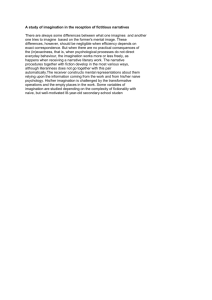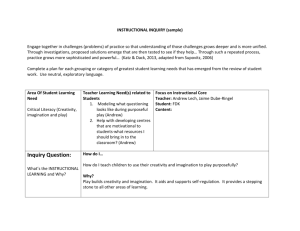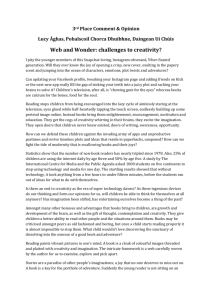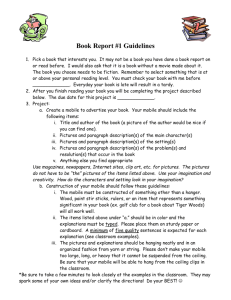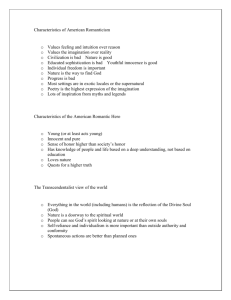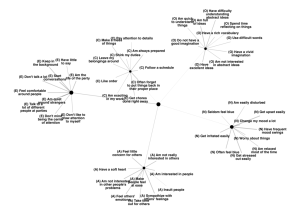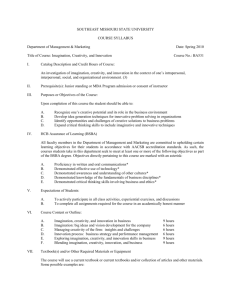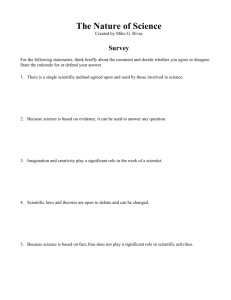Imagination for life and learning - full plan
advertisement
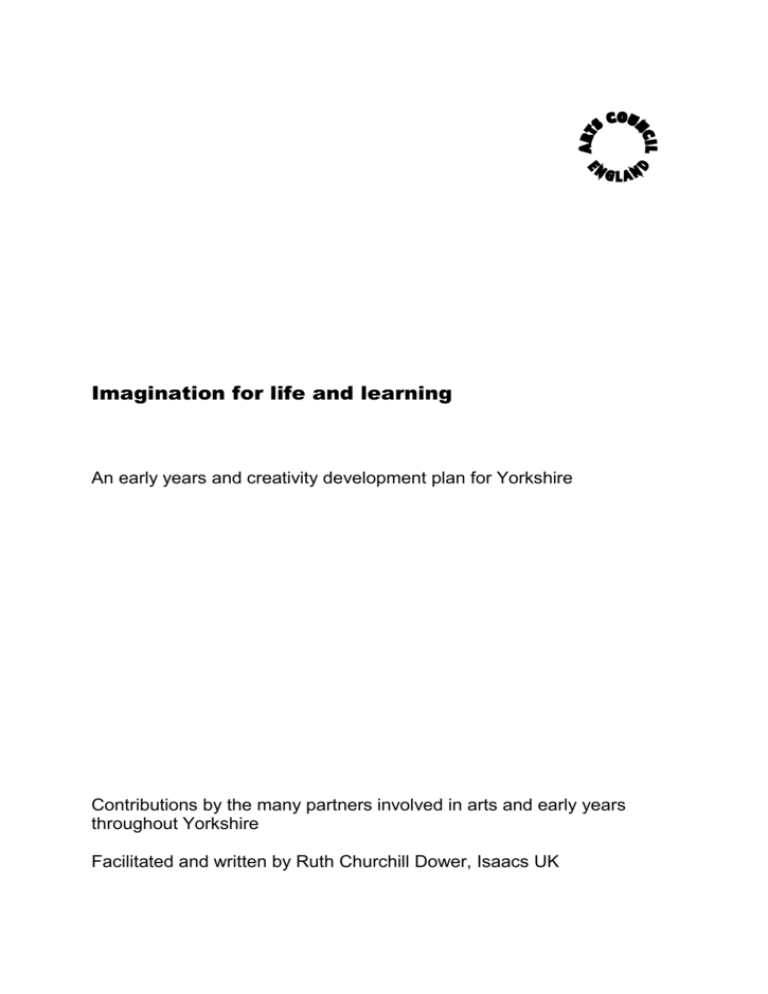
Imagination for life and learning An early years and creativity development plan for Yorkshire Contributions by the many partners involved in arts and early years throughout Yorkshire Facilitated and written by Ruth Churchill Dower, Isaacs UK Contents 1 2 Imagination for life and learning – an introduction .............. 3 Framework for the development plan .................................. 5 Brief from Arts Council England, Yorkshire .............................................5 3 National and regional context .............................................. 7 Regional strengths ....................................................................................10 Regional weaknesses ...............................................................................10 4 Visions and guiding principles ............................................ 12 5 Identified issues for the region and recommendations for action ......................................................................................... 13 5.1 Professional development ...............................................................13 5.2 Capacity and resources ...................................................................14 5.3 Mainstreaming and sustainability ...................................................16 5.4 Advocacy ...........................................................................................18 5.5 Putting the plan into action ..............................................................19 6 Appendices .............................. Error! Bookmark not defined. 6.1 Bibliography ............................................ Error! Bookmark not defined. 6.2 Methodology ........................................... Error! Bookmark not defined. 6.3 Acknowledgements ................................ Error! Bookmark not defined. 6.4 Map of current provision ........................ Error! Bookmark not defined. 6.5 National policy flowchart for arts and early yearsError! Bookmark not defined. 6.6 The value of arts and creative practice in early years: signposts to further reading................................................. Error! Bookmark not defined. Imagination for life and learning 2 1 Imagination for life and learning – an introduction This is a brave and timely document. Brave in that its pages are studded with terms from a lexicon long unfamiliar to early years practitioners, too long bombarded with the language of public accountability: goals, targets, standards and competences. Here the key words on every page are signposts to a different territory: a place of vision and growth, of knowledge sharing and advocacy, an environment of security, respect and belonging. It is timely in two ways. First in its scrupulous, detailed attention to the current regional and national scenes, and the bewildering variety of initiatives and organisations with links to services to children, the creative arts, and early years provisions of every kind, here masterfully mapped and referenced. And secondly, in its uncompromising orientation towards the future: the plan is, simply, to build a better place for children to live their childhoods in. And yet, as I read, while recognising the importance of the politics of the present moment, and convinced by the argument that at this same moment the early years community, in its widest sense, is facing a ‘crucial opportunity’, I was reminded more than once of voices from the past that we would do well to remember. I thought of the words of other writers and thinkers who long ago expressed some of the profound ideas that underpin this development plan: the relation between creativity and freedom, the deep emotional engagement that drives serious learning, the centrality of the imagination in children’s lives. Simone Weil, for example, the great French philosopher and mystic, wrote (in a beautiful essay on the dignity of human labour) that ‘in human effort the only source of energy is desire’1. What an inspiring expression of the necessity to shape our early learning environments so as to make room for children’s desires. For their irrepressible and inventive energies, for what this document calls their ‘natural languages of creativity’. And an earlier writer still, George MacDonald, author of the classic children’s stories The Princess and Curdie and At the Back of the North Wind, writing of ‘the necessity we are under to imagine’, describes the work of the imagination in these amazing words: 1 Weil, S. (1941) Pre-requisite to dignity of labour, in Miles, S. (ed) Simone Weil: An Anthology London: Virago Imagination for life and learning 3 The region belonging to the pure intellect is straitened: the imagination labours to extend its territories, to give it room. She sweeps across the borders, searching out new lands into which she may guide her plodding brother. The imagination is the light which redeems from the darkness for the eyes of the understanding2. As the title of this document so strongly asserts, imagination must be the stuff of ‘Life and Learning’ if we are to do well by children. The development plan goes on to show that we can, and we will. Mary Jane Drummond Writer and researcher Langthwaite, North Yorkshire, January 2006 2 MacDonald, G. (1983) The Imagination: Its functions and its Culture, in A Dish of Orts London: Sampson Low, Marston & Co. Imagination for life and learning 4 2 Framework for the development plan ‘There are two values which you can give a child as a present for life. First of all roots, and then wings.’ (Native American proverb) There is much research and evidence as to the positive impact on children’s development (social, physical, health and well-being, educational, skills, civic and so on) through engagement with arts from an early age, and within an environment committed to developing creative approaches to teaching and learning, whether the focus is arts related or not. This development plan is about finding ways of increasing this impact and, in some cases, simply helping arts and early years practitioners to engage with quality creative practices in the first place. The plan offers a unique opportunity to develop a regional vision for the growth of the arts and early years sectors to which all practitioners and policy makers can contribute and share. It provides a framework for all partners to map, place and value their current activity within a broader context. It gives us an opportunity to better understand and navigate government agendas, and gives localised work a much greater sense of place and strength within the region. Through a comprehensive consultation process, the key visions, challenges and opportunities being experienced by the region’s practitioners were identified and acknowledged. This in turn helped us to identify the resources and infrastructure needed to map out our journeys and, more importantly, how we could better support each other in doing so. The development plan will help Arts Council England, Yorkshire to deliver the national Children, young people and the arts strategy in a more coherent and meaningful way for the region. The knowledge sharing and advocacy that can be achieved more powerfully together than individually, will give the region long deserved recognition for its arts and early years achievements, and help to raise the profile of the excellent work of our practitioners at national and international levels. Brief from Arts Council England, Yorkshire To design a regional development plan for the arts and early years sectors in synergy with the national Arts Council England strategy for children, young people and the arts. Imagination for life and learning 5 Objectives stimulate early years arts and creative activity enhance opportunities to share good practice increase practitioners’ and organisations’ capacity through training and professional development build international links, leading on from the International creative practice in early years settings research to broaden our horizons and learn about other practice strengthen local connections, the programme and resource base of the early years and creativity Hub build sustainability and longevity develop advocacy and profile raising through strategic partnerships ‘grow’ the infrastructure Imagination for life and learning 6 3 National and regional context We are living and working in times of great change, particularly around the immense growth and investment by the Government in a visionary early years infrastructure. The exciting thing about this sector is that policy and practice have a dynamic and evolving influence on each other. At the same time, our arts and cultural policies are being repositioned to actively engage, and be influenced by, children and young people from all cultures and societies. In England and other European countries, Ministries of Education, Culture and Health have begun to recognise the fundamental importance of the work of creative practitioners to the healthy and balanced development of a child from the earliest stages, and have started to support this with wide ranging policies and dedicated budgets. It is a crucial opportunity for practitioners and policy-makers alike to come together in planning, implementing, learning from, and changing practice on a large and meaningful scale. Creative approaches to teaching, learning, thinking and doing have been widely recognised as suitable and valuable mechanisms – firstly for achieving the tremendous quality of life all children and their families should have access to, and secondly, for building a set of attributes and skills to prepare them for the best possible start in life. In the last five years in particular, we have witnessed important moves in both policy and practice. The National Childcare Strategy (1998) set out the basic framework for development of childcare services and education. This was progressed by the green paper, Every Child Matters: Change for Children (2003) and housed within a groundbreaking legislative framework, The Children Act (2004). The Act sets out the requirement for all children’s services to be integrated, and aspires to place the wishes and needs of children’s services, parents and learners centre-stage. At a local level, these changes are being led by the new directors of Children's Services in local authorities, bringing together education and children's social services. Local authorities, Primary Care Trusts, and others are beginning to pool budgets into a Children's Trust to support more joined up services on the ground. The Government has also appointed a new Children's Commissioner in England, to advise Government as to the effectiveness of these services. Imagination for life and learning 7 In view of the new duties to work in cooperation, providers of childcare, education, health, employment and parenting support are joining forces with each other to become one-stop-shop Children’s Centres. These centre-based integrated multiagency services aim to better meet the needs of families in the 20% most disadvantaged wards in England and improve both children's life chances and their parents' access to work and training. At the same time, schools are expanding their remit to provide a more community orientated base, and dawn-todusk ‘wrap-around’ care for children including early years, referred to as the Extended Schools Agenda. Integral to achieving these strategies is the new learning framework for nought to five-year-olds called the Early Years Foundation Stage, combining aspects of Birth to Three Matters (Sure Start, 2003) and the Curriculum Guidance for the Foundation Stage (Qualifications and Curriculum Authority, 2000), which was part of the National Primary Strategy. The new framework will focus on meeting the individual needs of children and highlight the importance of learning through play. It recognises the importance of nurturing creativity in the care and education of children, and has already opened up huge opportunities for the arts sector to interact with early years. The move to integrate services through Children’s Centres, Children’s Trusts and Children’s Services, will hopefully see a much more coherent and strategic development of what has become a segmented and over-burdened sector. However, some people fear that the danger of over-simplification of services through their centralisation will eradicate the possibility of meeting individual needs. The arts and creative sectors have much to offer in ensuring this does not happen. One of the most important roles they can play is in supporting a child’s entitlement to celebrate their own, and others’, cultural identities, encourage their individual expression, and to do so within an environment of security, respect and belonging. The Arts Council’s national publication of the Children, Young People and the arts strategy states that: ‘The arts can contribute to achieving all five outcomes outlined in Every Child Matters: being healthy, staying safe, making a positive contribution, achieving economic well-being, and enjoying and achieving. We have seen a steady stream of evidence which demonstrates the impact of the arts in achieving these outcomes – particularly when we work in partnership with other sectors such as health, education and youth justice…. We believe that everyone in England, Imagination for life and learning 8 through early childhood to young adulthood and beyond, should engage with the highest quality of arts and creative experiences.’ This strategy is underpinned with strong campaign messages about the value and transformational power of the arts, namely that: every child has the right to experience the arts and creativity children's creative experiences today benefit tomorrow's community and economy an amazing artistic experience as a child can provide an inspiration for life arts and creativity enhance teaching and learning In the arts sector at a national level, there have been several initiatives 1 to raise the profile of the arts within education, including The Arts Education Interface, Spaces for Sport and Arts, Creative Partnerships, Artsmark, young people’s Arts Awards, Building Schools for the Future, and specialist Arts Colleges which are now focussing their energies on transition strategies, continuing the work started by creative practitioners at Primary level. Other initiatives have produced guidance specifically for arts and early years work including Reflect and review (2005) (see footnote five), and ‘Things that artists should know about working with the early years sector’. It is within this context that Arts Council England, Yorkshire has developed its own regional plan outlining the delivery of the national priorities, in collaboration with the diverse network of partners who are essential to the success of this work for children. For the last few years, Arts Council England, Yorkshire has laid the foundations for an excellent base of creative practice across the region. The Education and Learning Team has: fostered the sharing of skills and knowledge through the early years and creativity Hub, open to all involved in arts and early years practice; hosted a national conference exploring different approaches to creativity in early years; commissioned and published research into international models of creative practice in early years settings; and offer tailored guidance and support to funded organisations and individuals working in this field. The time is right to crystallize the many and varied opportunities for developing this work and foster the growth of these sectors in a coherent and sustainable way. 1 Details of all Arts Council England initiatives and publications here: www.artscouncil.org.uk Imagination for life and learning 9 However, Yorkshire is not without its own regional challenges experienced by arts and early years practitioners trying to work together. Some of these are outlined below and form the basis for the visioning work that regional partners have carried out in designing this development plan. Regional strengths high levels of creative activity in early years settings Arts Council England support for innovative work across the sectors, particularly through Creative Partnerships and Local Authority partnerships the Early Years and Creativity Hub is growing and has good strategic links across the arts and education sectors Arts Council England’s recent Children, young people and the arts strategy provides a strong strategic framework to support early years work Yorkshire is well positioned to take advantage of national strategic opportunities such as supporting and enhancing the delivery of the emerging Children’s Services strong commitment to link in to these agendas from all partners involved several artists and companies are already working across the early years sector, some of which are Arts Council England funded, and an established culture of residencies exists emerging recognition of quality work in the region at international levels several practitioners have already participated in training and professional development in creative approaches to early years work, and are aware of its benefits Regional weaknesses lack of a networking infrastructure at sub-regional levels (particularly rural areas) disparate opportunities for the longer-term development of creative practice and little strategic connection or relevance to the wider policy contexts, leading to short-term funding initiatives rather than sustainable partnerships need for higher status for early years in the arts and education sectors lack of quality assurance framework for cross-agency work with stakeholders such as parents, carers, practitioners, and artists Imagination for life and learning 10 2 need for joint thinking and planning between Arts Council England, other NDPBs2, and LEAs3 on supporting strategies to ease the transition periods between Foundation Stage (early years), Key Stage 1 (primary) and Key Stage 3 (secondary) so that essential skills and attributes built up through creative practice and imaginative play are not lost within a more regimented curriculum complexities of LEA policies can make funders inflexible and unapproachable towards partnership opportunities fear of further division between arts and early years provision within the new Children’s Services fear of the centralisation of Children’s Services promoting the delivery of creativity as a ‘package’ where one size is intended to fit all, to solve all problems, and with little space to explore individual needs and cultural contexts few strategic connections for profiling the region at national levels within DfES, QCA and DCMS Non Departmental Public Bodies, agencies with a national and regional remit to advise on and deliver central government policies at arms length such as Sport England, the Museums, Libraries and Archives Council, and English Heritage as well as Arts Council England 3 Local Education Authorities who now have the remit to provide the infrastructure for delivery of all Children’s Services, in partnership with several stakeholders such as Sure Start, Children’s Centres, and schools. Imagination for life and learning 11 4 Visions and guiding principles Children have the right to participate in cultural and creative experiences in order to help develop their natural languages of creativity and understand and appreciate their own, and other people’s, diverse cultural environments. Access to life-changing arts experiences should not be dependent on a child’s circumstances. Children’s entitlement to arts and culture should be based on a cluster of values such as enjoyment, freedom, democracy, justice, peace, equal respect for the individual and for the community – not on inflexible educational or social systems. Everybody should take responsibility for enabling children’s entitlement to culture and to learning. This should be driven both by national policy and grass-roots action to ensure that all policy development is directly and continually informed by practice. Providers and supporters of such opportunities should base their work on the principles of: inclusivity; mutual respect; excellent quality; listening to children; active engagement, interaction and participation; holistic learning through play and fostering the imagination; access to the environment; and engaging the support system of the child/family. Creative practice, be it for artistic, cultural, social, educational, economic, environmental or other means, should be embedded into everyday practice. It should be recognised for the important contribution it can make to a child’s life either as a creative means in its own right or as a tool for development. Everyone can be creative if they feel inspired, safe, and confident enough. Having arts skills, although useful, is not a pre-requisite to creative teaching, learning, thinking or doing. The early learning environment should be a safe space to explore and learn with enough time to facilitate creativity, the right people to support the process who can think laterally, and resources which are fit for the purpose. The ethos of such space should be process-orientated rather than productdriven, and be flexible enough to encourage risk-taking (both adults and children). Time to plan, to do, to observe, to listen and to reflect should be embedded into the environment. All learning should be expressed and captured as much as possible and continually fed in to the practice and organisational change. The ultimate aim should be to harness a natural learning ‘space’ which can happen anywhere at any time. Imagination for life and learning 12 5 Identified issues for the region and recommendations for action 5.1 4 Professional development Seek opportunities for professional early years artists and teachers to work with each other through mentoring, leadership, exchange programmes (including our international partners’ programmes – see footnote 13) or apprenticeship schemes between beacon settings, arts organisations or artists and those beginning the journey. Such exchanges would allow the sharing of new knowledge and skills, and challenge institutionalised thinking within established practices. They would also provide an open door through which new recruits to arts and early years work can walk in with good quality guidance and support for their own career development. Investigate good practice frameworks such as Investors in People4 which promote healthy people, leadership and change management, to complement guidance that concentrates primarily on organisational, process and practice change, such as Reflect and review5 and Keeping arts safe6. Provide opportunities for Hub partners to develop shared visions and learning from each other through Cluster Groups specifically for peers from each sector. Cluster Groups would aim to model good practice by investigating what constitutes good quality work, forthcoming opportunities for creative partnerships, what hasn’t worked, challenging boundaries, sharing policy and practice development, and processes for planning, ideas, reflection, evaluation, and so on. The importance of sector-based groups reflects the need expressed by artists, early years advisers, and educationalists, for forums where issues affecting each other’s practice can be discussed at a deeper level due to Investors in People is a framework to increase standards in an organisation and covers staff, organisation, leadership, learning and business management. Details here: www.investorsinpeople.co.uk 5 Reflect and Review: the arts and creativity in early years by Jo Belloli and Felicity Woolf, published by Arts Council England, August 2005. Available here: www.artscouncil.org.uk/publications 6 Keeping Arts Safe provides guidance for artists and arts organisations on safeguarding children, young people and vulnerable adults. Available here: www.artscouncil.org.uk/publications Imagination for life and learning 13 the shared knowledge of each other’s work contexts. It also reflects the lack of suitable training and professional development opportunities within peer groups for tackling these issues in ways that can change practice. Establish a sustainable training programme for cascading learning and skills development between practitioners, teachers, parents, children, and artists. This could be designed to integrate with, or complement, the LEAs current early years training and should also provide opportunities to focus on less ‘common’ artforms such as architecture, textiles, multimedia, photography and interactive performance. Opportunities should be explored for establishing a regional advisory framework to support the delivery of children’s and cultural services, consisting of a body of specialist advisors, such as Hub members, with expertise in specific areas of creative practice in early years, and who are able to advise on good practice for arts organisations, LEAs, schools, settings, childminding networks, and so on. Increase access to quality information and knowledge on current creative practice by supporting the development of the earlyarts7 web based resource bank of current early years creativity projects and theory being developed in the UK and abroad. Involve teacher training and higher education institutions such as arts, dance, music and drama schools, colleges and universities in Hub meetings in order to influence the design of arts or early years course materials, encourage the use of early years artists to deliver content, and better link supply to demand. Opportunities should be explored for arts and early years placements schemes in the workplace aimed at building creative awareness and skills for students at all levels. 5.2 7 Capacity and resources Identify sources of funds which could be concentrated on providing access to basic creative practice opportunities such as: cover for staff earlyarts is the arts and early years network for the north west, which has built and piloted a regional resource bank on creative practice and theory in early years. The use of this resource has been so successful, the opportunity now exists for the resource bank and artists database to become nationalised region by region, starting with the north of England. Its new site and Resource Bank is to be launched in Spring 2006. Details here: www.earlyarts.co.uk Imagination for life and learning 14 attending training and networking; funding for trained creative practitioners to work alongside parents, children, teachers, or artists; investment in equipment for documentation as a valuable legacy for settings and an alternative to formal assessment. Seed fund longer-term action research (perhaps in partnership with the CARA8 Awards) to enable educators and artists to develop skills and capacity which has a lasting legacy for both. This might explore barriers to, and impacts of, creative practice upon children’s learning; and the most conducive environments for creative thinking and learning to flourish. The learning from such research would have a dual purpose. It would allow the space for each individual setting, artist or arts organisation to build a knowledge of what works best within their own contexts, firstly enabling adaptations and cultural changes to become embedded over a longer period, secondly to establish a series of fundamental benchmarks in good practice for future work in other settings. These benchmarks might address issues of building confidence, ambition, motivation, shared languages, meeting individual learning needs, and so on. Secure commitments to longer-term investment in early years creative programmes, in partnership with national frameworks such as Creative Partnerships, Youth Music, Sure Start or local frameworks such as Universities and LEAs. Such work would require a rethink of funding categories to encompass ‘trials’ or ‘pilots’ as it is often difficult to show sustainability at the outset of projects, but no less important to have the space and resources to do this work. In tandem with the Resource Bank, partners should support the development of a regional artists database containing information on those available to work in early years areas, accessed through a brokerage service (run by AXIS9) which questions why enquirers want to work with an artist, and leads them through a diagnostic planning process to ensure sustainability and fitness for purpose. In addition, a public database of 8 Creativity Action Research Awards (CARA) which are run nationally by CAPE UK. Details here: www.capeuk.org. 9 AXIS is a national arts and education agency which has been developing good practice frameworks and providing a brokerage service for artists and schools, particularly where there are no Creative Partnerships or arts education agencies, since 1991, including the earlyarts north west database. More details here: www.axisweb.org Imagination for life and learning 15 projects seeking partners can be developed and serviced through the Hub or sub-regional network meetings. Quality assurance, evaluation, and reflective practice mechanisms should be explored for wider use by the Hub or Cluster Groups such as MLAC’s inspiring learning for all10, Reflect and review (see footnote five), Investors in Children (IiC) kitemark (see footnote four), and KEEP11 the SHEEP12 frameworks in order to raise standards and expectations, particularly in the arts sector. There is a fine balance to be struck between taking the value out of creative practice by over-regimenting its review processes, and not being able to measure and value it at all, thereby losing important opportunities for evidence-based advocacy at policy level. 5.3 Mainstreaming and sustainability A more coherent positioning of arts and early years practice in relation to priority agendas for Yorkshire is required. This will help to: clarify the ‘fit’ of such work and its outcomes within strategic contexts, enhance stakeholder relationships, influence regional policy, merge strategic initiatives where possible to reduce strategy overload, and build a critical mass of demand for this work. The arts sector in particular needs to come alongside LEAs to offer partnerships both in policy and practice which seek to fulfil those agendas centred in early developmental learning – perhaps entirely through creative practice. However, where such offers are being made, it is important that a well trained workforce, along with high quality creative products or services, are already in place, some mechanisms for which are identified in the section on professional development. The timing for such strategic partnership development is particularly crucial as the emerging children’s services identify the key players in delivering the early years learning and healthcare agendas. Other key cultural 10 Museums, Libraries and Archives Council’s planning and evaluation toolkit: www.inspiringlearningforall.gov.uk 11 Key Elements of Effective Practice (KEEP) for early years practitioners. Details here: www.standards.dfes.gov.uk 12 The five outcomes for children and young people set out in Every Child Matters – keeping children Safe, Healthy, Enjoying and achieving, Economically secure, and making a Productive contribution (SHEEP). Details here: www.everychildmatters.gov.uk and www.surestart.gov.uk Imagination for life and learning 16 stakeholders who should be considered in delivering these strategies include Yorkshire Museums, Libraries and Archives Services, Sport England in Yorkshire, Yorkshire Culture, MusicLeader, Youth Music Action Zones in Yorkshire, Yorkshire Forward, and Government Office Yorkshire and Humber. Opportunities should be provided to raise the status for arts and early years work by disseminating the region’s good practice and brokering synergistic relationships with important national stakeholders including Sure Start, QCA, OfSTED, Family Learning Organization, ContinYou, 4Children, Ragdoll Foundation, Pre School Learning Alliance, SkillsActive, Sector Skills Councils, Arts4Schools, Curiosity and Imagination, CABE, Creative Partnerships, Youth Music, ENGAGE, National Children’s Bureau, Action for Children’s Arts, Future Builders, National Association of Children’s Information Services, and others who have an early years remit (see national policy flowchart in Appendix 5.5 for details). Building on the Arts Council England research into International Creative Practice in Early Years13, explore opportunities for researching and piloting an arts-based education pedagogy, investigating how alternative pedagogies (such as Reggio Emilia14 or Te Whariki15) can enhance the early years curriculum to actively increase children’s engagement with learning, reducing the loss of children’s creative capacity during the transition period between early years and primary. This could include areas such as: creative approaches to assessment, evaluation and documentation aimed at making learning visible rather than for accountability; different working relationships between artists and teachers; focuses for staff development and cultural change through creative practice; secondary teachers working alongside primary to understand the roots of children’s learning and build creative transition 13 International Creative Practice in Early Years by Ruth Churchill Dower, published by Arts Council England, Yorkshire, November 2004. Download a full copy or executive summary here: www.artscouncil.org.uk/publications 14 A town in Northern Italy with an international reputation for early childhood education, described as ‘the Reggio approach’. Practice in these municipal infant-toddler centres is based on the idea that creativity is a central component of thinking and of responding to the world. Details here: http://zerosei.comune.re.it/ 15 Maori term for the Early Childhood curriculum taught in New Zealand: a holistic curriculum responding to children's learning and development and the wider context of the child's world. It emphasises the learning partnership between staff, children and family, and encourages a deep sense of belonging. Details here: www.minedu.govt.nz Imagination for life and learning 17 strategies. Several international partners have expressed the desire to be involved in such research and piloting work, which would complement any international exchange programmes designed under the section on professional development. Create safe environments for venue/festival programmers and early years or arts educators to build confidence in selecting and booking quality artists or companies to work with. Opportunities for artists to share practice and explore potential partnerships might include open forums, brokership programmes through the artists database, and regional showcases. Arts Council England should further support the promotion of early years through each artform policy in line with the Children, young people and the arts strategy. Opportunities for internal and external training to raise awareness of the issues involved should be made available as well as joint departmental planning across artforms to establish family friendly strategies for implementation by regularly funded organisations and other agencies. The early years and creativity Hub should engage external expertise to help members prepare for future strategic priorities such as citizenship, intergenerational work, family learning, and cultural entitlement. The remit of the Hub should include a commitment to ‘rebranding’ and repositioning arts and early years work by advocating it within the broader contexts that can give it greater legitimacy and presence. 5.4 Advocacy Identify Hub partners willing to be creativity champions using their professional position and strengths to advocate and deliver the development plan, develop and change their own internal strategies, and influence regional or national policy development where possible. The Hub should engage in a cultural and early years recruitment drive to ensure all the relevant partners are invited to contribute and are aware of its existence as a regional resource and knowledge base. Support the engagement of parents and carers in children’s creative learning and play by promoting the role of the arts in children’s overall development and challenging misconceptions about arts practice. This could happen by providing information on small but effective activities for Imagination for life and learning 18 the home, or through parents promotional postcards containing key messages, eg ‘why music is good for you’, or through family arts-based learning programmes in settings and arts venues. Build an evidence bank with all partners to use as an advocacy tool showing the success and the impact of creative practice on the lives of children and their carers or workers. The Hub could take the role of identifying the indicators, frameworks, factors and environments for success, and design the format for capturing and collating evidence across the region. A series of advocacy opportunities should be actively pursued such as Radio 4’s programme The Learning Curve, which regularly features the impact of creative practice on learning. A coordinated advocacy strategy should focus on opportunities for promoting key messages with examples from practice across the region, and be linked in to current issues likely to attract press attention, such as innovative approaches to parental involvement, Extended Schools, and Sure Start. The Hub should have representation at various stakeholder conferences once its remit is more established and its resource, knowledge and evidence banks are developed. Such work could be featured as a model of good practice through a postcard, a small promotional publication, or a DVD Toolkit based on regional projects. 5.5 Putting the plan into action Arts Council England, Yorkshire has laid the foundations for the development plan to be realised in a coherent and sustainable way. The plan is a significant step forward in opening up a number of opportunities for individual and community development right across the region. Primarily, it will fulfil the main objectives of the Children, young people and arts strategy by enabling and embedding, with all our partners, a culture of responsibility and commitment to children’s creative learning and development over a significant period of time. For the plan to realise its potential, it is essential to work together with the diverse community of stakeholders who are also committed to the principles and values set out in section three. Arts Council England, Yorkshire intends to facilitate the next stage of realisation through a series of partnership discussions that will identify an action plan for delivering the recommendations. Much of this discussion will take place through the Early Years and Creativity Hub, complemented by Imagination for life and learning 19 discussion with other policy-makers and practitioners whose work is outside of, but impacting upon, the arts and early years sectors. For the plan to work, it is essential that we find a way of making it deliverable within our sectors, and build capacity where it is needed. To achieve this we need to engage with all of our partners at all levels. This process is open to all to become involved with. We look forward to building these relationships further, working with all our partners to meet the challenges of this region and secure a better, and more creative, future for our children. For more details and to get involved in the Early Years and Creativity Hub, contact: Stephanie Simm Education and Learning Officer Arts Council England, Yorkshire Tel +44 (0)1924 486208 Email stephanie.simm@artscouncil.org.uk Imagination for life and learning 20
